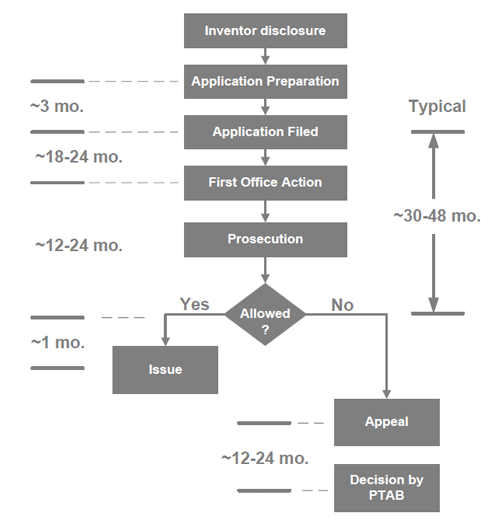Patent Process
Application Preparation:
The preparation of a patent application begins with a good disclosure by the inventor(s). Usually, an inventor writes a document explaining his or her invention. The level of detail may vary, but usually it should be enough detail so that someone having ordinary skill in the particular technology can understand the details. If the inventor works for a company with an established patent program, the disclosure may be well developed. If the inventor is not assisted by a patent professional, the disclosure may require more information.
The application preparation process will generally include a meeting with the inventor(s). It is our goal is to conduct the most comprehensive and complete first disclosure meeting possible. A good first disclosure is key to an efficient preparation process that will reduce the burden on the inventor. If possible, we prefer in-person disclosure meetings, but we also routinely conduct teleconference disclosure meetings and web-based conferences.
Our firm implements specific processes for drafting a patent application to ensure the broadest protection allowable or the protection desired by the client. In drafting the specification, we also ask inventors to provide detailed examples and viable alternatives, which is recommended to ensure that adequate support is provided for each claim term. We also take pride in drafting claims that not only cover our client's invention, but also provide adequate scope with the competition in mind. It is our goal to provide a first draft that is substantially complete, and will be ready for filing without undue revision cycles.
Prosecution:
In this process, the U.S. Patent and Trademark Office (USPTO) will issue one or more Office Actions. The Office Actions are reports where examiners of the USPTO outline reasons for rejecting or objecting to the originally filed patent application or amended application. During this process, amendments may be made to the claims or parts of the application in an attempt to overcome rejections and/or objections. Usually, every application is rejected based on prior art found by the examiner during his or her search, and our responses to those rejections are made to fine tune the scope of the patent claims to overcome the prior art. This process can take one or more cycles, so we generally provide our clients with guidance at each step to ensure that resulting claims will protect our client's IP innovations.
Issue:
If the claims of the application are found to be allowable, the examiner will issue a Notice of Allowance (NOA). In response to the NOA, an issue fee must be paid to the USPTO for the patent to be printed.
Appeal:
If the application is not allowed after one or more cycles of prosecution, a decision to appeal may be in order. Usually, an appeal is filed contesting the examiner's findings regarding the prior art and the currently rejected claims. The appeal process can delay the ultimate issuance of the patent, so consideration should be given to additional amendments to the claims. If the patent claims are valuable and the examiner's position is believed to be unreasonable, an appeal is usually the best route for advancing the prosecution of the application.


